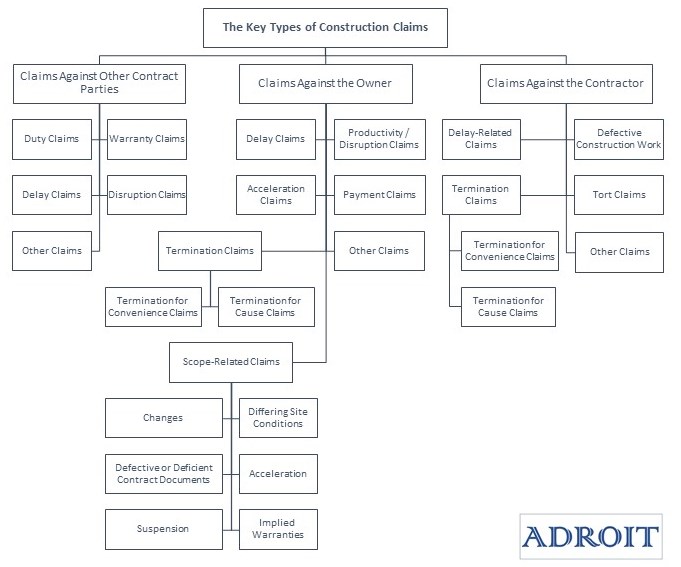Dr. Maryam Mirhadi, PMP, PSP
A wide range of claims may arise between contract parties in a construction project. In case of a construction claim, one or more parties seek entitlement to a time extension or compensation for damages under the terms of a legally binding contract. Construction claims can be categorized in a variety of ways and based on different criteria. This short article identifies the main construction claims and categorizes the main construction claims in a tree-like structure that can be used as a basis for the identification and review of such claims.
AACE International® defines claims as “a demand or assertion of rights by one party against another for damages sustained under the terms of a legally binding contract. Damages might include money, time, or other compensation to make the claimant whole” [1]. The PMBOK Guide [2] provides a slightly different definition and states “contested changes and potential constructive changes are those requested changes where the buyer and seller cannot reach an agreement on compensation for the change or cannot agree that a change has occurred. These contested changes are variously called claims, disputes, or appeals”.
As the above definitions suggest, a claim is made when one or more parties demand their contractual rights. These demands are materialized in the form of seeking entitlement to time extension or compensation for damages.
Construction claims can be categorized in a variety of ways and based on different criteria. One may categorize construction claims based solely on responsibilities; whereas, another practitioner may prefer to categorize construction claims based primarily on their cause. The following tree-like structure provides an example structure that can be used to categorize the key types of construction claims.

As the above figure illustrates, construction claims can be categorized into three main categories of claims against the contractor, claims against the owner, and claims against the other contract parties. Claims against the contractor can further be broken down into delayed-related claims, defective construction work, tort claims, termination claims, and other claims. These claims are typically made by owners and they primarily arise when an owner finds out that the contractor has not satisfied certain contract requirements in one way or another. Under such circumstances, the owner claim arises because the owner believes the contractor has failed to perform one or more obligations required under the construction contract.
Claims against the owner are primarily made by contractors. These claims typically arise when contractors find some of the assumptions they made during the bidding phase to be invalid. These assumptions may have been made about project scope, project specification, site conditions, or about other project requirements such as expected delivery dates of owner-furnished equipment or material. These claims can generally be categorized into delay claims, productivity / disruption claims, acceleration claims, payment claims, scope-related claims, termination claims, and other miscellaneous claims.
Claims against the other contract parties can be categorized into the main groups of duty claims, warranty claims, delay claims, disruption claims, and other claims. These claims can be against a design firm that prepares and governs the design process, construction management firm that manages the construction process, or any other major role player who is involved in contract disputes.
Since the relationship between contract parties is governed by the terms of the construction contracts, these terms are the basis against which entitlements should be assessed and determined. In assessing construction contracts, not only contract forms and contract documents must be evaluated, contemporaneous evidence and records must also be assessed to ensure entitlements are assigned in a reasonable and equitable manner. A tree-like structure to categorize construction claims, such as the one provided above, is a good starting point to properly identify construction claims and differentiate between the types of construction claims that may arise in a construction project.
References:
[1]. AACE International®. Recommended Practice No. 10S-90 Cost Engineering Terminology. Morgantown, WV: AACE International, 2023
[2]. Project Management Institute. (2021). A guide to the project management body of knowledge (the PMBOK Guide). Newtown Square, PA: Project Management Institute.
